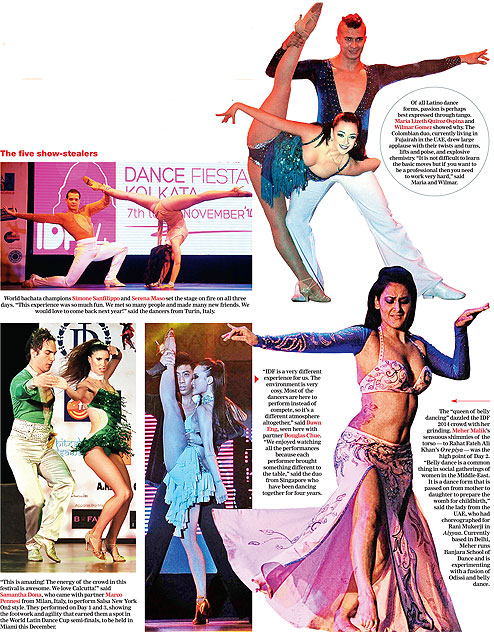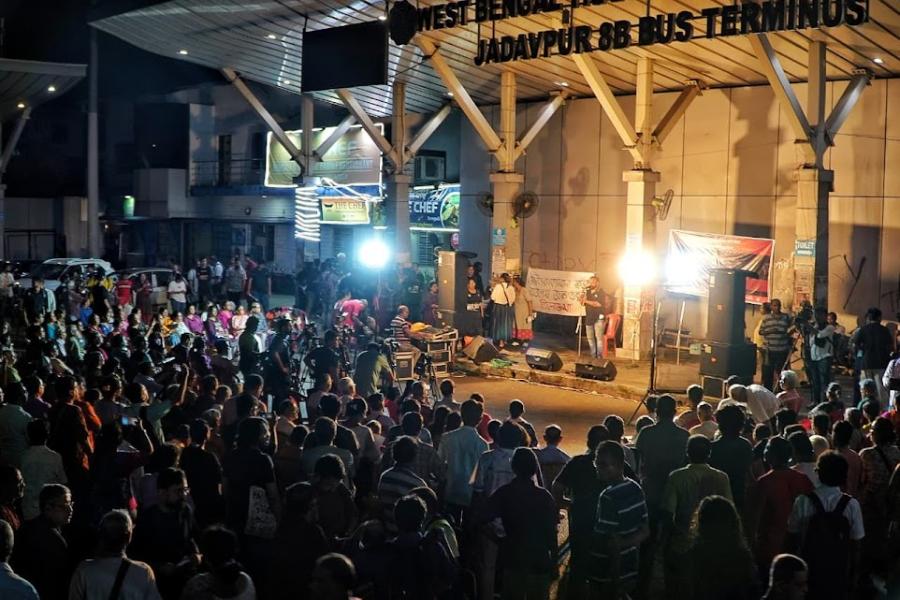Salsa, zumba, tango, bachata, mambo, zouk, tap dance, cha-cha-cha, merengue, rumba, jive, jazz, hip hop, robot.... Masters of more than 20 Latino dance forms worked up a frenzy at the International Dance Fiesta 2014, presented by Zodiac Entertainment and Mambo City India in association with t2, at Dalhousie Institute over the last weekend. The three-day festival not only had jaw-dropping performances by experts but also amateurs shaking a leg with a tip or two from the pros at workshops and boot camps. The t2 highlights...
 |
 |
Shimmying to salsa
 |
| Participants dance to the tune of Dawn and Douglas from Singapore at the Introduction to Salsa workshop |
Most Bengali children are made to learn some kind of art form. I was promptly enrolled into Hindusthani classical music lessons. My mother, having learnt singing and dancing, also wanted me to pick up dance. But she soon accepted the fact that her younger daughter had two left feet. Since then, I have stayed away from the dance stage (apart from the occasional and really embarrassing colony performances during Durga Puja and Rabindra Jayanti). Even in nightclubs, my dance steps only include the chicken dance and robot.
I was excited to be attending the International Dance Fiesta because I enjoy watching dance performances and IDF had lined up some amazing artistes. I’ve always found Latino dance fascinating. The way the dancers move with so much grace and fluidity. With so many daily workshops on the schedule, I finally swallowed my fear of dance and decided to give it a shot. I chose one of the easiest (or so I thought) workshops for beginners.
The salsa workshop by Dawn and Douglas from Singapore was slated for Day 2. I stood in the first row, excited but nervous. Dawn and Douglas began teaching the class, slow at first, without music, with special emphasis on their feet movements. They showed us what to do with our arms and bodies. Step by step, slow at first, then with music.
“Girls, pop out your butt, and boys, why don’t you shimmy your upper body?” they instructed.
I could follow the movements when slow, but as soon as the music came on, I would lose my step and stop. The others, however, didn’t have any trouble keeping up. That’s when I realised that I should probably stop being so self-conscious and ease up a little. Slowly, I stopped worrying about who was watching and how I looked, and began shimmying to the music (which is quite addictive). At the end of an hour, I felt a bit confident about my moves.
Douglas and Dawn were fabulous teachers. They even let us take a video of the routine they taught us. I can keep going back to the video and practise till I’m perfect (or as close to it as I can get) but till then, I’m going to stick to the robot in public.
Dance like nobody’s watching
 |
| Strangers bond at the zouk workshop |
When I signed up for a dance workshop at the IDF 2014, all I thought was that I would learn ballroom dancing, the way they show it in Hollywood films. Girl and guy, her hand on his shoulder, his hand by her waist, and a little swaying to some old-school jazz tune. I was excited. I was tense. I was apprehensive of making a fool of myself. For me, even bhashan dance is a Herculean feat.
The first thing that our instructor Richard David Tholoor, one of the pioneers of acrobatic salsa in India, said was, “Don’t see it as a dance. See it as a lovely art where we can communicate with each other without speaking, without actually knowing the person. Just share a moment of joy.” He introduced us to the steps of zouk, a Brazilian social dance.
As we were made to stand in pairs, a beautiful girl came and stood right in front of me!
Then on the count of 1-2-3, the music started and there we were — holding each other, smiling and trying to follow the steps that David had just showed us. The music would stop every 30 seconds and we would switch partners. Every time there was a new girl, I had butterflies in my tummy. And before I could realise what was happening, my first partner came back in rotation. We smiled, a smile of knowing each other, a smile of being comfortable, an infectious smile that said a lot without speaking.
It takes years to learn any dance form, zouk is no exception. But what I learnt that day is why
Latino dance forms are called social dance forms. Being a smoker, I know for sure what smoking does. It kills. But it also helps bond with complete strangers — sharing a light, puffing away as if you are old buddies. That day I discovered how to do the same without killing myself. All I need to do is get up and move, dance like nobody’s watching!
 |











